ISSN ONLINE(2319-8753)PRINT(2347-6710)
ISSN ONLINE(2319-8753)PRINT(2347-6710)
Hari Om1, Sunil Pandey2
|
| Related article at Pubmed, Scholar Google |
Visit for more related articles at International Journal of Innovative Research in Science, Engineering and Technology
Control of bead geometry and dilution is of utmost importance during overlay cladding. Bead geometry is decided by its Width, Reinforcement and Penetration depth. Weld penetration shape factor (WPSF) is another term that provides the information about penetration pattern. Many high deposition arc welding processes are in use for cladding and surfacing for decades but dilution remains more or less a problem while using these processes. In the present work, advance submerged arc welding (ASAW), a relatively improved process has been used for cladding AISI 308L stainless steel over mild steel substrate plate to study the effect of ASAW parameters on WPSF. Mathematical equation has been developed using response surface methodology (RSM) to predict WPSF in terms of ASAW parameters. During the analysis, it was found that wire feed rate, open circuit voltage and preheating current affect significantly WPSF.
Keywords |
| Advanced Submerged Arc Welding, Weld Cladding, Weld Penetration Shape Factor, Response Surface Methodology, Central Composite Design |
INTRODUCTION |
| Cladding is a form of surfacing application where a relatively thick layer of a corrosion resistant alloy is deposited on a plain carbon or low alloy steel substrate[1, 2]. Corrosive and high temperature atmospheric conditions demand engineering components to show satisfactory corrosion and/or heat resistant properties. In order to provide long life to carbon steel components at relatively low cost, austenitic stainless steel overlay cladding is done to make them corrosion resistant. Literature reveals that many austenitic stainless steel grades are used for cladding carbon or lowalloy steels [3-8]. Among the fusion welding processes,Gas Metal Arc Welding, Shielded Metal Arc Welding, Gas Tungsten Arc Welding, Flux Cored Arc Welding and Submerged Arc Welding have been used for cladding [3, 5, 7- 14]. In the present work, Advanced Submerged Arc Welding process, due to its certain merits over conventional Submerged Arc Welding process, is used for cladding AISI 308L stainless steel on mild steel plate. Amathematical model has been developed to study the effect of ASAW process parameters on weld penetration shape factor (WPSF).Weld penetration shape factor is defined as the ratio of bead width and depth of penetration. It is also called the coefficient of internal shape [7, 15]. Mathematically, WPSF can be represented as �������� = ��/��, where W and P are the Bead Width and Depth of Penetration respectively as shown in Figure 1. |
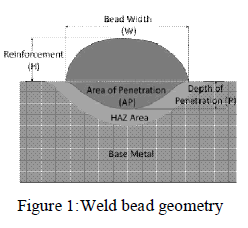 |
ADVANCED SUBMERGED ARC WELDING |
| Advanced Submerged Arc Welding (ASAW) is a recently developed welding process in the Welding Research Laboratory of Indian Institute of Technology Delhi (Sunil Pandey, 2004, Patent application number: 2533 / DEL / 2008 Dated: November 07, 2008). Its working principle is based on conventional submerged arc welding process with a difference that the continuously fed wire electrode is electrically preheated with the help of a separate auxiliary power source before it enters into arc region. The contact tube through which the continuous wire electrode is passed is made into two parts which are separated by a dielectric gap. With the help of main power source, welding current is passed through the electrode and the base metal in order to create arc for melting. The auxiliary power source as stated is used to preheat certain length of electrode wire. The schematic diagram of the ASAW setup is shown in Figure 2. |
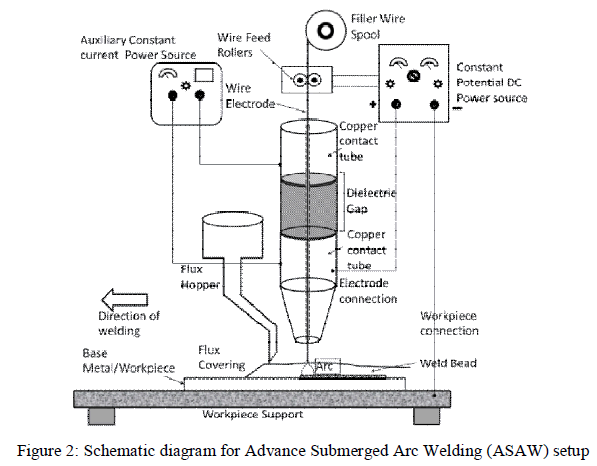 |
| ASAW process, in this way, fetches the energy required to bring the electrode wire in molten state in two steps i.e. through resistance preheating of electrode wire as well as by providing welding current between the electrode and the base metal to create arc. It has been established from the previous research that a striking reduction in welding current due to preheating of electrode is noted during welding which in turn lessens arc force. This leads to lower penetration depth and thus reduced weld dilution and make the process more suitable for surfacing applications [16] |
EXPERIMENTATION |
| A. Experimental setup |
| The experimental runs were performed on Advanced Submerged Arc Welding equipment. A direct current constant potential (DCCP) power source with a rated current capacity of 600 amperes at 60% duty cycle with mechanized welding head was used for the experimentation. |
| B. Material selection and identification of process parameters limits |
| A ‘single bead on plate’ technique was adopted to deposit beads of SFA/AWS 5.9 class ER308L stainless steel single bare wire electrode of 3.15 mm diameter on 300 mm x 75 mm x 12 mm mild steel plates. A compatible agglomerated flux of class AWS SFA A-5.23 was used to shield the weld metal from atmosphere. The bead was deposited at the centre of each plate along its length in order to have equal heat dissipation rates on both sides of the bead. |
| Independent ASAW parameters i.e. wire feed rate F, travel speed S, open circuit voltage Vo and nozzle to plate distance D and preheating current IP were carefully chosen for the present work. |
| The decision on working limits of selected parameters was based on numerous trial runs. Low and high levels of each parameter were finalized by inspecting the resulting bead on plate carefully and only those beads were accepted which did not show any visible welding defects during trial experiments. The limiting values of parameters are shown in Table 1. |
| C. Design matrix and experimental procedure |
| The five levels of each independently controllable ASAW parameters were selected and coded as -2, -1, 0, +1 and +2 as given in Table 1 and then design matrix consisting 30 test conditions based on half fraction rotatable central composite design (CCD) was formed as illustrated in Table 2 using Design Expert 8 statistical software. |
| Stainless steel beads thus deposited on mild steel base plates according to design matrix were allowed to cool in still air up to room temperature. In order to maintain the uniformity in bead properties and their chemical composition, start and stop portions of 50 mm length were discarded off by cutting both ends of plate. Three bead on plate specimens of about 15 mm width (one at centre and two at both the ends) were then taken out from remaining length of plate. After careful mounting with Bakelite, the specimens were polished sequentially using finer grades of polishing papers. Important bead zones were exposed by etching the specimens with 2% Nital solution. Bead width and penetration were measured by scanning the specimens. . Resulting Weld Penetration Shape Factor (WPSF) corresponding to each test experimental run is also presented in Table 2. |
 |
DEVELOPMENT OF MODEL |
| A. Response surface methodology |
| Response surface methodology (RSM) is useful for modelling and analysis of problems that include number of variables and where objective is to optimize the multiple responses[17, 18]. Response function Y can be expressed in terms of process parameters as |
| The model includes the main effects and interaction effects of all the factors in the form of first or second order polynomial correlations. Second order polynomial, which was assumed for the current study, is represented by following general equation. |
| Where β0, βiiand βij are constant regression coefficients and xiandxjare the process variable and ϵ is the error term of the model [19]. |
| B. Estimating the adequacy of developed models and significance of coefficients |
| The adequacy of the model was established by using Analysis of Variance (ANOVA) technique[7]. The outcomes of ANOVA for the WPSF are given in Table 3. This table shows details of degrees of freedom (DF), sum of squares (SS), mean square (MS), F- Ratio and Probability of larger F- value or simply P-value. Calculated F-value for the model was found larger than tabulated F-value at 95 % confidence level which indicates the adequacy of the model. The "Pred RSquared" of 0.7418 is also found in reasonable agreement with the "Adj R-Squared" of 0.7908.Figure 3is a normal probability vs. Studentized residuals plot for all the observations of WPSF. It can be determined that the assumption of a normal distribution is judicious since all the plotted points follow a straight line. |
| The statistical significance of the coefficients can be established by using the t- test and F-test. Coefficients having Fvalues less than or equal to the standard tabulated F-value at 95% confidence level, are considered non-significant and can be ignored without affecting much the accuracy of the proposed model [20-24]. Table 3shows also the P-values for individual parameters in the model. Underlined values, where P-values are more than 0.05, depict non-significant parameters and are consequently dropped from the model. |
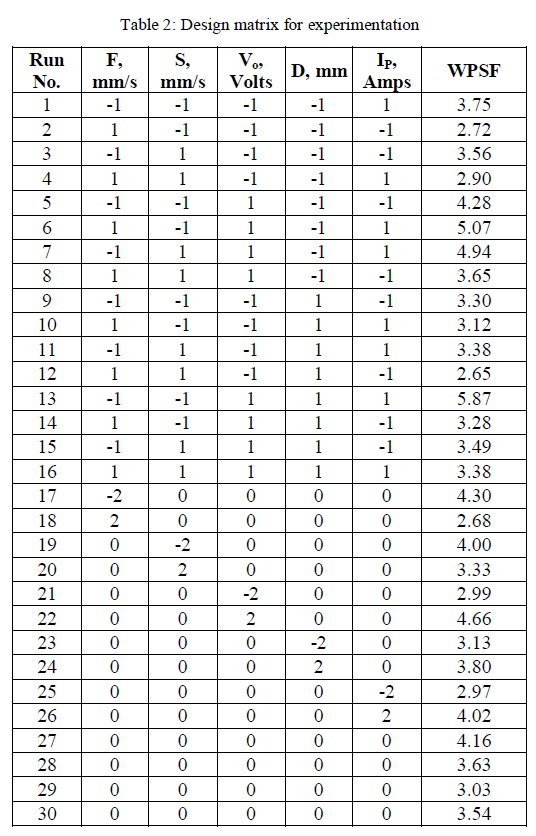 |
RESULTS |
| A. Development of Final mathematical models |
| Following equations have been finalized keeping significant parameter coefficients and omitting insignificant parameter coefficients. Equation 2 represents regressions in terms of coded factors, where B, C and E are the coded symbols for welding speed S, open circuit voltage Voand preheat current IP. Equation 3 shows correlation in terms of actual factors. |
 |
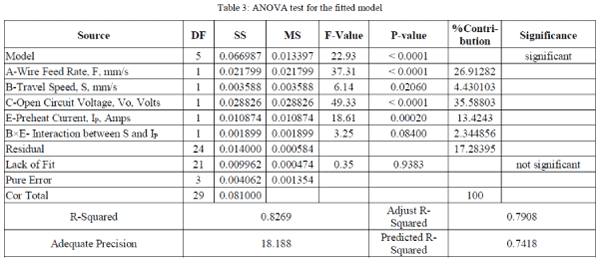 |
| B. Direct effect of ASAW parametrs on WPSF |
| Regression model equations 2 and 3 show the influence of ASAW parameters on the WPSF and Figure 2(a) represents graphically the individual effect of each parameter on WPSF. In Figure 4(a), A, B, C and E are the coded notations for Wire feed rate F, Travel speed S, Open circuit voltage VO, and Preheating current IP respectively. It is clearly indicated that WPSF decreases when F and S are increased and it increase when VO and IP are increased. With the help of ANOVA as shown in table 3, percentage contribution of each ASAW parameter can be evaluated. It can be seen that the parameter which affects the WPSF in the most influential manner is open circuit voltage VO (%contribution = 35.58) and second comes the wire feed rate F (%contribution = 26.91). Then follow the preheating current IP and Travel speed S (%contribution = 13.42 and 4.43 respectively). In this way travel speed S is influences WPSF the least. It is to be noted that F is directly controlled by the main welding current. |
| C. Interaction effect of ASAW parameters on WPSF |
| Equations 2&3and Figure 4(b) illustrate that only two ASAW parameters i.e. Travel speed S and Preheating current IP have interaction effect on WPSF. As can be seen in Figure 4 (b), at lower level (4.0 mm/s) of travel speed S, rate of increase WPSF with respect to Preheating current IP is significantly slow as compared to higher level (7.0 mm/s) of the same. In other word, it can be said that for lower level (42 A) of Preheating current IP, effect of travel speed is negligible while at higher level (126 A) of IP, travel speed S shows a strong negative effect on WPSF. Surface plots shown in Figure 5 and Figure 6 illustrate the combined effects of two ASAW parameters simultaneously in different combinations. Plots have been drawn for parameter ranges from -1 to +1 since accuracy of prediction is highest in this range. |
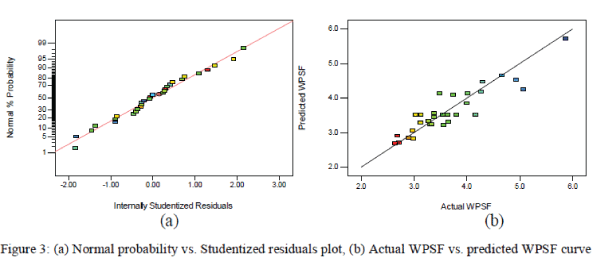 |
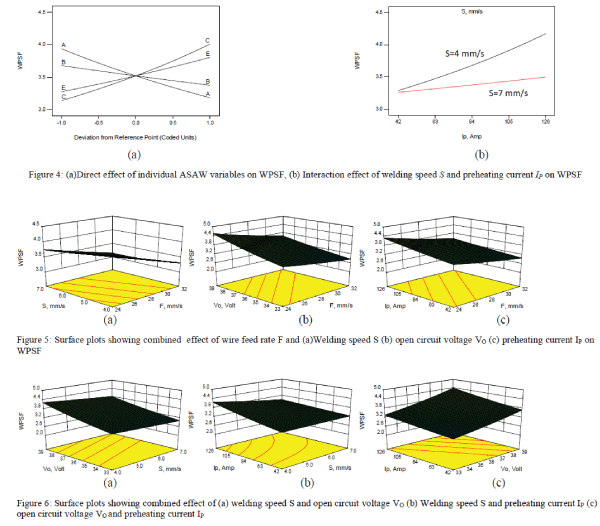 |
CONCLUSION |
| 1. Mathematical model for WPSF in terms of ASAW parameters has been developed. |
| 2. Wire feed rate and open circuit voltage are found to have great influence on WPSF as compared to other ASAW parameters |
| 3. By increasing the wire feed rate and decreasing the open circuit voltage during cladding, decreased values of WPSF can be achieved. |
| 4. An increase in preheating current, which is a special feature of ASAW, WPSF increases. |
| 5. WPSF should be maximized for cladding operations, thus lower levels of wire feed rate and travel speed and higher levels of open circuit voltage and preheating current should be used. |
References |
|